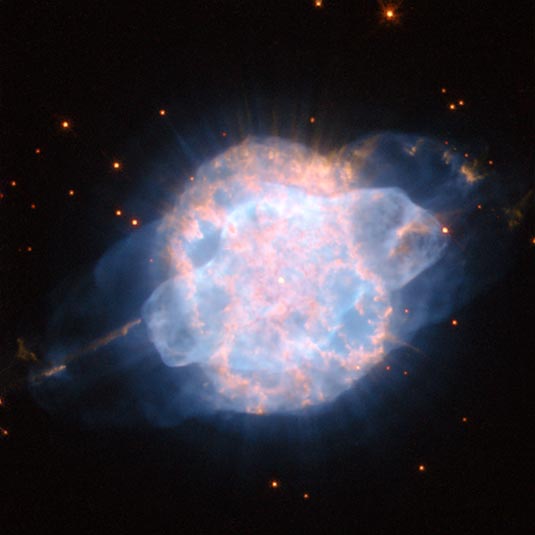
A Piercing Eye In The Sky
Description: Planetary Nebula
Position ( J2000): RA 11h 50m 17.7s Dec -57° 10' 56.9?
Constellation: Centaurus
Distance: est. 3000 to 6800 light years
Diameter: 0.3 light years
Apparent magnitude: 8.5
Apparent dimensions: 8 to 10 arcseconds
Image Credit: ESA/Hubble and NASA
Release Date: August 2, 2010
ABOUT THIS IMAGE:
This
dramatic image from the NASA/ESA Hubble Space Telescope shows the planetary
nebula NGC 3918, a brilliant cloud of colorful gas in the constellation
of Centaurus, around 4900 light-years from Earth.
In the center of the cloud of gas, and completely dwarfed by the nebula,
are the dying remnants of a red giant. During the final convulsive phase
in the evolution of these stars, huge clouds of gas are ejected from the
surface of the star before it emerges from its cocoon as a white dwarf.
The intense ultraviolet radiation from the tiny remnant star then causes
the surrounding gas to glow like a fluorescent sign. These extraordinary
and colorful planetary nebulae are among the most dramatic sights in the
night sky, and often have strange and irregular shapes, which are not
yet fully explained.
NGC 3918's distinctive eye-like shape, with a bright inner shell of gas
and a more diffuse outer shell that extends far from the nebula looks
as if it could be the result of two separate ejections of gas. But this
is in fact not the case: studies of the object suggest that they were
formed at the same time, but are being blown from the star at different
speeds. The powerful jets of gas emerging from the ends of the large structure
are estimated to be shooting away from the star at speeds of up to 350
000 kilometers per hour.
By the standards of astronomical phenomena, planetary nebulae like NGC
3918 are very short-lived, with a lifespan of just a few tens of thousands
of years.
The image is a composite of visible and near-infrared snapshots taken
with Hubble's Wide Field Planetary Camera 2. The filters used were F658N,
F814W, F555W and F502N, seen in red, orange, green and blue respectively.
The image is about 20 arcseconds across.
From Wikipedia:
NGC 3918 is a bright planetary nebula in the constellation Centaurus,
that is called the "Blue Planetary" or "The Southerner".
It is the brightest of the far southern planetary nebulae. This nebula
was discovered by Sir John Herschel in March 1834, and is easily visible
through small telescopes. The round or even slightly oval diameter is
telescopically between 8 to 10 arcsec, though deep images extends this
to about 19 or 20 arcsec. More surprising is the beautiful rich blue color
that looks much like the colored images of Neptune taken by Voyager 2
in 1989.
Spectroscopy reveals NGC 3918 is approaching us at 17±3.0 kilometers
per second, while the nebulosity is expanding at around 24 kilometers
per second. The central star is 15.7B magnitude, and remains invisible
to optical observers. Distance is estimated at 1.5 kpc